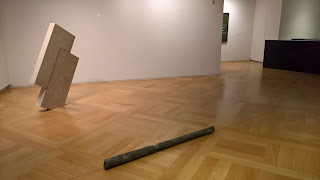Last week to the Royal Institution to hear Dame Sue Black tell us about her work as a forensic anthropologist, which turns out to be code for someone who identifies bodies in circumstances where DNA does not do the job for you. A warm and attractive lady, a personality providing welcome balance to the rather gruesome nature of her work.
Lots of small birds on the edge of the roof of the second block of flats as one approaches the station from West Hill. Was is just the early evening social gathering or were they roosting for the night? Were they nesting up there? See reference 1 for a corvine example of this sort of thing.
Oddly, no aeroplanes to be seen from the platform, despite the clear view to the northern horizon.
Train quiet. And for once in a while they had two down escalators and one up, rather than the other way around, which meant that concourse area at Vauxhall was quiet too. While the Goat was busy, with people all over the pavement, some smoking. But a proper city pub with more or less instant service.
Snapped some no doubt expensive art in Albemarle Street. Not clear from the street whether the carefully cut stone (or whatever) and the rusty pipe were one work or two works.
Lecture theatre around two thirds full, with the young lady next to me having very neat handwriting and a taste for very small print on her telephone, far smaller than I could read with any comfort at any distance, while she could manage at an ordinary reading distance. But she did concede that she would probably have to turn the size up in the not too distant future.
Dame Black was a very good lecturer, and she started out by explaining that the body changes with time, with very little of it being original by the time that we die.
DNA had come on stream in the middle of her career, but did not make her obsolete. DNA was great when you had a sample and a suspect, you could just match the one to the other. But a sample only led you to a suspect in the case that you already had a record for this last, so there was still a big role for the more old-fashioned techniques, for example looking at the history of the skeleton, at the various damage it had taken during life.
She told us the grieving relatives were not very good at identifying dead bodies, with lots of false positives and lots of false negatives. You needed more to be sure, and that was where she came in. And while you could sometimes take DNA from both relatives and victims, when you had related victims, the DNA could not tell them apart. You needed more.
Race was not usually of much help. She used a classification of four races: Mongoloid (east Asia), Negroid (sub-Saharan Africa), Papuan (Pacific islands, large and small) and Caucasian (rest of the world). So in her usage Caucasian was a much larger group than I was expecting, one that told one little about, for example, skin colour. But Wikipedia suggests that this is a controversial area.
A big part of her job appeared to be identifying pedophiles from photographs of parts of their body, often arms. It seems that pedophiles like to take pictures of their activities, which means their arms against the body of the their victims: pictures from which maps of veins of the forearms can be extracted, maps which amount to a sort of low-grade fingerprint which can be matched with a suspect - which one might well have in the form of the owner of the laptop from which the picture was taken. But high enough grade so that around 80% of the cases she works on result in change of plea, which means that the grade is good enough.
Hands, faces and teeth were all helpful for identification, while I forget about the use of ears by the French police in Simenon's day and I did not think to ask.
Computers are getting good at a lot of this, which is our only real hope of pushing back the tide of pedophile pornography which seems to be all over the deep and dark parts of the Internet, introduced at references 2 and 3. To which my response is very much the same as that to all the layers of effectively secret ownership provided by tax havens: why would you do it if you were doing anything even faintly respectable? Why do we allow it? See also reference 4.
For the first time for a while, the centre escalator at Vauxhall had been turned off, so I was able to climb the 65 steps. Something I do not attempt at Green Park, where there are getting on for a hundred.
Several fours at the aeroplane game at Earlsfield, and I came within a whisker of a five, which might have been a first.
PS: in the course of the proceedings, I was reminded that heritage drawing packages were even more of a problem for records people than heritage word processing packages. In the latter case one can capture a good deal of the content with an image, but that is not good enough for an architectural or engineering drawing.
Reference 1: http://psmv2.blogspot.com/2014/07/twit-log.html.
Reference 2: https://en.wikipedia.org/wiki/Dark_web.
Reference 3: https://en.wikipedia.org/wiki/Deep_web.
Reference 4: https://psmv4.blogspot.com/2019/01/city-boys-episode-2.html.

No comments:
Post a Comment